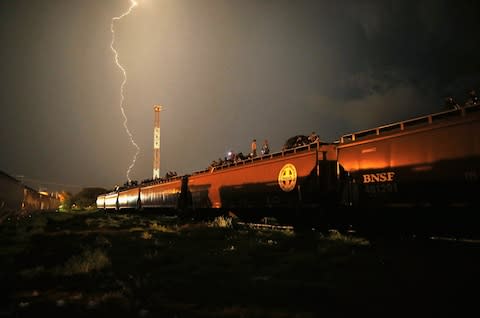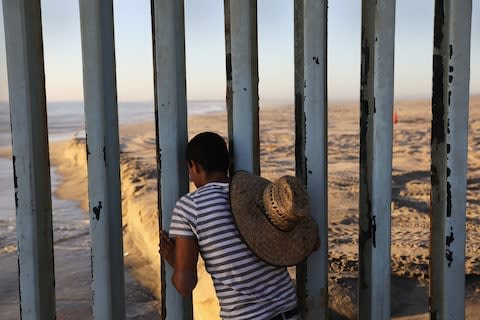Behind the Shutter: John Moore on chronicling the militarisation of the US-Mexico border

The scene is one all too familiar to the thousands of hopefuls who attempt to cross the US-Mexico border in search of a better life: migrants walking through the stifling summer heat of the Rio Grande Valley, near McAllen, Texas, before they are caught and taken into custody by US Border Patrol agents.
The image, taken in July 2014 by photojournalist John Moore, is now part of his new book, "Undocumented: Immigration and the Militarization of the United States-Mexico Border," spanning 10 years of reportage on both sides of the geographic and political divide.
"When I began this project, undocumented migration was not a major news story in the US media every day. Over time it has become more and more so," Moore told The Telegraph.

US President Donald Trump has made detaining and deporting illegal immigrants a pillar of his presidency and Immigration and Customs Enforcement (ICE) has reported a 40 per cent increase in arrests within the United States since he took office.
"Things have definitely changed since Trump became president. Initially when he was inaugurated there was a steep decline in undocumented immigrants coming across the border. I think this had to do with his harsh rhetoric which initially scared people away," Moore said.
"However, the reasons why people leave their countries have not changed, the violence is the same and we've seen the numbers of immigrants coming across slowly start to pick up over time."

The American photojournalist has been covering different sides of the migration issue ever since coming back from a long period working in Latin America, and has now decided to collect his work into a book to "humanise an issue which is often described in terms of statistics", he told The Telegraph.
"I wanted to show the conditions of violence and poverty that drive people to make such a dangerous journey to an uncertain future here in the US."

Part of his multi-sided approach led Moore to spend time with the US military and law enforcement. "Most border agents I've spoken with are as human as anyone, and any one of them feel compassion for immigrants that come across," he said.
"In fact many border agents speak Spanish as their first language and there are many Latinos in the US border patrol. Their main objective is to enforce the law, they don't make the laws."
It was during one of his stints with the border patrol that Moore took one of the most resonant pictures of the book: "I had been photographing the border patrol one hot August afternoon when they received a call on the radio that a group of immigrants had been spotted crossing the border into the US.
"The border patrol called in a helicopter to surveil from overhead, they brought in a canine unit, and they began chasing the group in the thick underbrush and there was a 10-minute pursuit.

"I was on foot behind them, and when I caught up they had captured a group of maybe 10 central Americans, who were dusty and sweaty, and obviously very sad after being caught during such a difficult journey.
"I looked down and saw an image of a woman, with her thumb gently caressing the hand of the man she was handcuffed to. I had no time to interview them or speak with them. They were quickly taken away, and I still to this day wonder where they came from, I wonder who they left behind, I wonder who they hoped to be reunited with in the US. I also wondered if they came together at all or if they just met during a desperate and chaotic attempt to escape."

Moore also photographed parts of the network of cargo trains that come from southern Mexico up towards the US-Mexico border, also known as "La Bestia". "Undocumented immigrants use it because it's the cheapest way to travel. It also happens to be very dangerous," he said.
"People will ride for days, and sometimes even weeks, to reach the border. They are exposed to the elements, extreme heat and storms, and sometimes the tree branches can knock them off from the top of these train cars."
Moore has experienced riding the Beast himself through the Mexican state of Wahaca. "I had to climb aboard a moving freight train, and there were about 500 immigrants on top.
"I rode with them for several hours, and although it was just a small part of their journey, after just three hours I was completely exhausted and uneasy on my feet when I came down. Through that experience I came to realise just how difficult that journey is."

On the US side, arrests of foreigners living illegally in the United States have surged under President Trump, according to data released by the Department of Homeland Security. US authorities have also begun transferring into federal prisons 1,600 ICE detainees in the first large-scale use of federal prisons to hold detainees.
"The fact is the US is bound by international law to give due process to people seeking political asylum," Moore said.
"Many of the people coming across the border are families fleeing violence and so, whether Trump wants them or not, they have the right to due process to a hearing with an immigration judge, and those processes are often very slow."

However, while during the Obama administration many immigrants without serious criminal records were allowed to await their court dates while living in the US, Mr Trump has vowed to imprison them regardless of their criminal records.
"Under the Trump administration the government has gone after many non-criminal illegal immigrants. The mere act of having an illegal visa status is enough to be deported. They are after people who are otherwise law abiding citizens," said Moore.
What is clear to Moore in the ever-changing landscape of migration to the US is what pushes people to risk their lives and freedom for a shot at the American Dream.
"Most immigrants, whether they are documented or undocumented, they've come to the US for the sake of their families, and I believe that many have come as an act of love."

 Yahoo News
Yahoo News 
